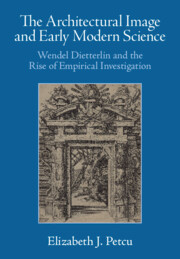 The Architectural Image and Early Modern Science
The Architectural Image and Early Modern Science Book contents
- The Architectural Image and Early Modern Science
- Reviews
- The Architectural Image and Early Modern Science
- Copyright page
- Dedication
- Contents
- Editorial Note
- Acknowledgements
- Introduction The Renaissance of Architecture as Art and Science
- One Architecture’s Figural Turn
- Two Devising the Architectura: Rationalism and Empiricism in Architectural Design
- Three Drafting the Architectura: Drawing as Research in Art, Architecture, and Science
- Four Printing the Architectura: Architectural Etching Becomes Alchemical Inquiry
- Five Dissecting the Architectura: Anatomy, Ornament, and the Limits of Figuration
- Six Deconstructing the Architectura: Enduring Matter and Transient Forms in Peru
- Conclusion The Death and the Life of the Architectural Image
- Select Bibliography
- Index
Five - Dissecting the Architectura: Anatomy, Ornament, and the Limits of Figuration
Published online by Cambridge University Press: 29 November 2024
- The Architectural Image and Early Modern Science
- Reviews
- The Architectural Image and Early Modern Science
- Copyright page
- Dedication
- Contents
- Editorial Note
- Acknowledgements
- Introduction The Renaissance of Architecture as Art and Science
- One Architecture’s Figural Turn
- Two Devising the Architectura: Rationalism and Empiricism in Architectural Design
- Three Drafting the Architectura: Drawing as Research in Art, Architecture, and Science
- Four Printing the Architectura: Architectural Etching Becomes Alchemical Inquiry
- Five Dissecting the Architectura: Anatomy, Ornament, and the Limits of Figuration
- Six Deconstructing the Architectura: Enduring Matter and Transient Forms in Peru
- Conclusion The Death and the Life of the Architectural Image
- Select Bibliography
- Index
Summary
As architectural images became vehicles for natural philosophical thinking and practices, they also challenged certain conventions of architectural design. Dietterlin’s Architectura upended enduring principles of architectural naturalism and stability promoted in Leon Battista Alberti’s De re aedificatoria by developing a genre of amorphous ornaments that resembled the internal forms of the human body while effacing the conventional distinctions between architectural structure and surface, interior and exterior. Dietterlin derived these corporeal ornaments from empirically oriented images such as anatomical flap prints and the woodcuts of Vesalius’s De corporis fabrica. As architects and artists in northern Europe adopted the Architectura’s anatomical ornaments, they revealed the limits of architectural naturalism. Paradoxically, the waxing role of architectural images as tools for studying and embodying nature destabilized architecture’s long-standing traditions of naturalistic design.
Keywords
- Type
- Chapter
- Information
- The Architectural Image and Early Modern ScienceWendel Dietterlin and the Rise of Empirical Investigation, pp. 297 - 346Publisher: Cambridge University PressPrint publication year: 2024
